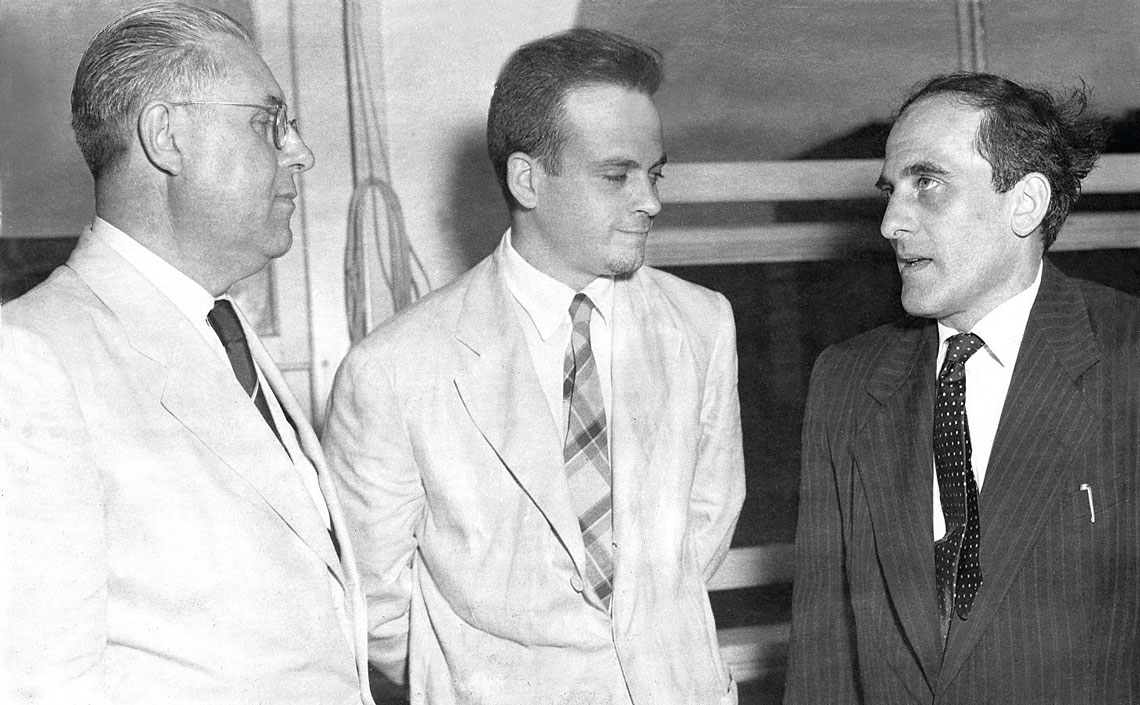In addition to having a major impact on the study of cosmic rays and particle physics, César Lattes, even as a young researcher, played an important role in the institutionalization of science in Brazil. In January 1949, shortly after returning from working at the cyclotron (a type of particle accelerator) at the University of California, Berkeley, he helped found the Brazilian Center for Physics Research (CBPF) in Rio de Janeiro (see report on page 56). Together with a small group of scientists, including physicists José Leite Lopes (1918–2006), Jayme Tiomno (1920–2011), and Elisa Frota-Pessôa (1921–2018), he created the institution’s initial center of excellence.
Nuclear physics was a growing field after World War II due to the success of the USA’s Manhattan project, which built the first atomic bombs. In Brazil, both the military and the federal government, as well as various industrial sectors, were interested in creating a center that would specialize in experimental and theoretical physics. It was a period of strong nationalism and development.
In a 1976 interview with the Getulio Vargas Foundation’s Center for Research and Documentation of Contemporary Brazilian History (CPDOC-FGV), Lattes said that he had the idea of creating the CBPF before he even left Berkeley. The university’s physics department was extremely important to nuclear research in the USA in the 1930s and 1940s, largely due to the work of physicist Ernest Lawrence (1901–1958), inventor of the cyclotron and winner of the Nobel Prize in Physics in 1939.
“The CBPF was conceived in California,” Lattes told CPDOC. The leadership at the University of Brazil, which is now the Federal University of Rio de Janeiro (UFRJ), was unwilling to support the creation of a nuclear physics center. The only alternative was to found a private research institution. Lattes was its first scientific director, leading the institution from 1949 until mid-1955.
“The CBPF was initially funded by some scientists who were very financially comfortable and wanted to support the initiative, as well as foreign funding agencies, such as the Rockefeller Foundation, and business groups,” wrote Alfredo Tiomno Tolmasquim, from the Museum of Astronomy and Related Sciences (MAST), in an article published in the journal Revista Brasileira de Ensino de Física in January this year. “The University of Brazil offered some land on its campus to build the CBPF’s first building, which was funded by banker Mario d’Almeida.”
In 1975, after a series of financial and staffing crises, including persecution during the years of the military dictatorship from 1964 onwards, the CBPF was incorporated into the Brazilian National Council for Scientific and Technological Development (CNPq).

Memory Center / CNPqLattes (middle) and Italian physicist Giuseppe Occhialini with Armando Dubois Ferreira (wearing glasses), vice president of the CNPq in the early 1950sMemory Center / CNPq
The CNPq was originally named the National Research Council and it was Brazil’s first research funding agency, which Lattes himself happened to play an important role in creating. “Lattes’s participation in the founding of the CNPq was not as direct as with the CBPF, but, due to his great prestige at the time, his support was very important,” says Olival Freire Junior, a physics historian from the Federal University of Bahia (UFBA) and current scientific director of the CNPq. Six months after the organization was founded, the Brazilian Federal Agency for Support and Evaluation of Graduate Education (CAPES) was created.
There had long been demands to establish funding agencies in the country, ever since the 1916 creation of the Brazilian Science Society, which was the predecessor of the Brazilian Academy of Sciences (ABC). The calls grew louder toward the end of the 1940s, however, with the emergence of institutions such as the Brazilian Society for the Advancement of Science (SBPC), founded in 1948, and the CBPF itself the following year. The driving force behind the creation of the CNPq was Admiral Álvaro Alberto da Mota e Silva (1889–1976), who was also its first president. The Navy engineer represented Brazil on the Atomic Energy Commission at the United Nations Security Council.
Lattes’s final major contribution to Brazilian science may have been lending his name to the CNPq’s platform for sharing the academic résumés of researchers based in the country, which was created in August 1999. Today, the website has more than 200,000 subscribers and data on more than 35,000 research groups from around the country.
César Lattes’s own academic credentials are also available on the platform. His résumé can be found with a simple search as long as the “other researchers” checkbox is ticked. This option searches for people without a doctorate. By default, the website’s search function only checks its database for the names of registered researchers with a PhD. Lattes never defended a doctoral thesis, although he received an honorary doctorate from the University of São Paulo (USP) in 1948.
Republish